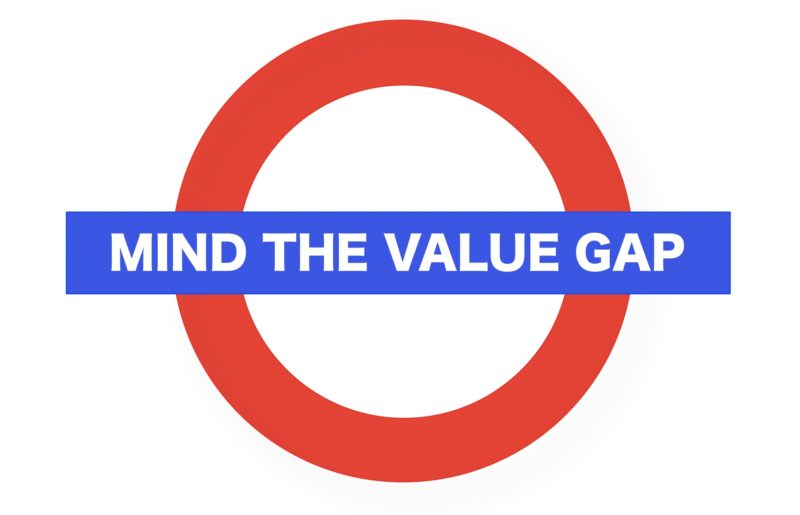
By Mark Boundy
The Secret of Selling … and Business: Mind the Value Gaps
The Secret of Selling … and Business: Mind the Value Gaps https://csuiteold.c-suitenetwork.com/advisors/wp-content/themes/csadvisore/images/empty/thumbnail.jpg 150 150 Mark Boundy https://secure.gravatar.com/avatar/fda1708afcd4681826f4fb12f56401d9?s=96&d=mm&r=g
Selling — and business — isn’t about what your customer says they want as much as it’s about what they value. Sure, translating from the first to the second takes skill, but that’s the reality. Customer value is at the heart of sales, marketing, customer experience, innovation, operations…everything in your business.
Value is the energy – the unseen force behind all business. Without value received in each direction, no transaction would take place. More profoundly, it drives every part of a customer’s buying process, like reading an advertisement, clicking on a web link, or agreeing to take a sales call. Nothing happens unless a prospect considers each next step worth his/her time. That is, they perceive a value gap: the expectation of a desirable outcome.
For most of the past decade, I’ve taken a deep dive into the craft of selling. However, I’ve always viewed selling not as a siloed corporate function but as a part of a bigger whole, combining my general management, value and pricing expertise with knowledge in sales and marketing. When you treat sales as its own silo, you leave a lot of potential growth and profits on the table.
Customers Buy…to Fill Value Gaps
Selling skills and methodology training all takes different paths to the same goal: uncovering value gaps, then showing the customer to fill them. These could be gaps the customer understands and describes…or those they don’t know to ask for. The sellers that confine themselves to customer-described value gaps are the ones that look –and sell — like everyone else…and compete on price.
Your expertise in your product or solution means nothing if you aren’t also an expert in your customer’s business. Only then can you help your customer achieve creative, differentiated outcomes.
The Way We Sell Today Leaves Value Gaps Ignored.
Companies silo themselves into functions. This is both good and bad. Silos are centers of specialized expertise, but they are also fertile ground for tribal dysfunction (according to anthropologists who study organizations). Think of all of the functions in your own company who regularly contact your customer. Now think about how many value gaps those “non-sales” roles uncover on a daily basis, but don’t do anything with. Finally, ask yourself what value-creation opportunities you are wasting.
Everyone who comes in contact with a customer should be considered a seller. Then, every seller in your company needs to be attuned to looking for value gaps. More important than closing such gaps when they can: carrying any/all value insights “back to the hive”. When your organization gathers a more holistic view of a customer – and all their value gaps – you put yourself in a better position to compete.
Customers Don’t Help.
Selling companies aren’t the only ones who silo themselves. Even more important, customers try to buy in silos. For example, a piece of hospital lab equipment might be sold to the lab silo, assisted by resources in purchasing, contracting, and perhaps facilities. However, if that piece of equipment fails – or even worse, starts giving incorrect results – think of all of the silos who are impacted. The list includes doctors, nurses, patient records, billing, legal, scheduling (for re-tests), loss prevention, finance, administration…and of course, purchasing, contracting, and the lab silo. Think about it this way: when that equipment is running properly, all those departments are still impacted and are potential areas for innovation and value creation.
Most B2B offers deliver value company-wide, but many sellers are oblivious to anything outside of the conventional selling box. Business acumen helps sellers analyze how an offer benefits to other areas of the company. When all of your sellers have business acumen, they’re equipped to sell outside of a customer’s compartmentalized buying mentality.
Even if you don’t buy into lofty goals like feeding customer-focused innovation, think narrowly and tactically. Silo-limited customers with narrow buying processes lock salespeople into poorly differentiated selling processes. The same organization scheme that focuses on expertise and drives efficiency restricts a broad exploration of solution impacts. If your offer delivers out-of-single-silo results (most do), limiting yourself to within-silo selling is an act of self-commoditization.
If You Invest in Differentiating Your Product/Service, You Gotta Pay for it
When a business generates value for a customer through a differentiated offer (product, service, or solution), a sale is made. Generate enough value and the seller can charge more than their costs. They can then reward their employees for building differentiated products, forge strong relationships with valued suppliers, invest in even more differentiation, and yes, share profits with investors.
As you can see, focusing on value gaps closes a lot of loops in an organization. Your sales silo can strengthen those loops or break them. Unfortunately, some metrics make a sales organization still look good while still delivering profit/value dysfunction. I regularly see scoring systems which focus inside-the-sales-silo only, instead of holistically.
It’s About Uncovering and Closing Value Gaps.
By “it”, I don’t just mean sales. I mean “a world-class business”. All sellers (everyone who touches a customer) should participate in uncovering gaps. Every function in your company participates in closing gaps. Don’t let how you’ve siloed your organization stands in the way. And don’t let your customer’s silos limit the value you bring.
If you want to talk about it some more, contact me. As always, share and/or like if you found this article worth your time.
To your success!

